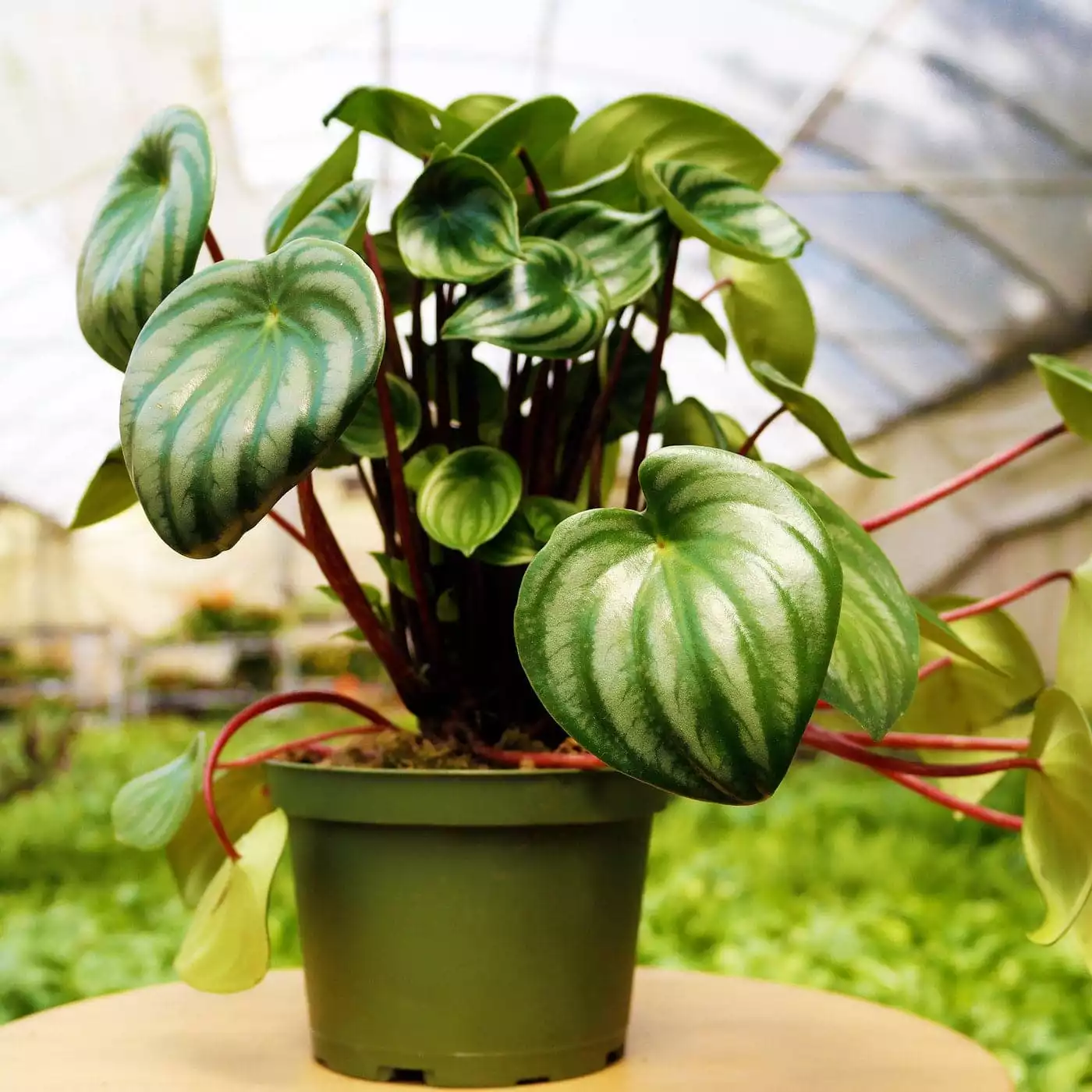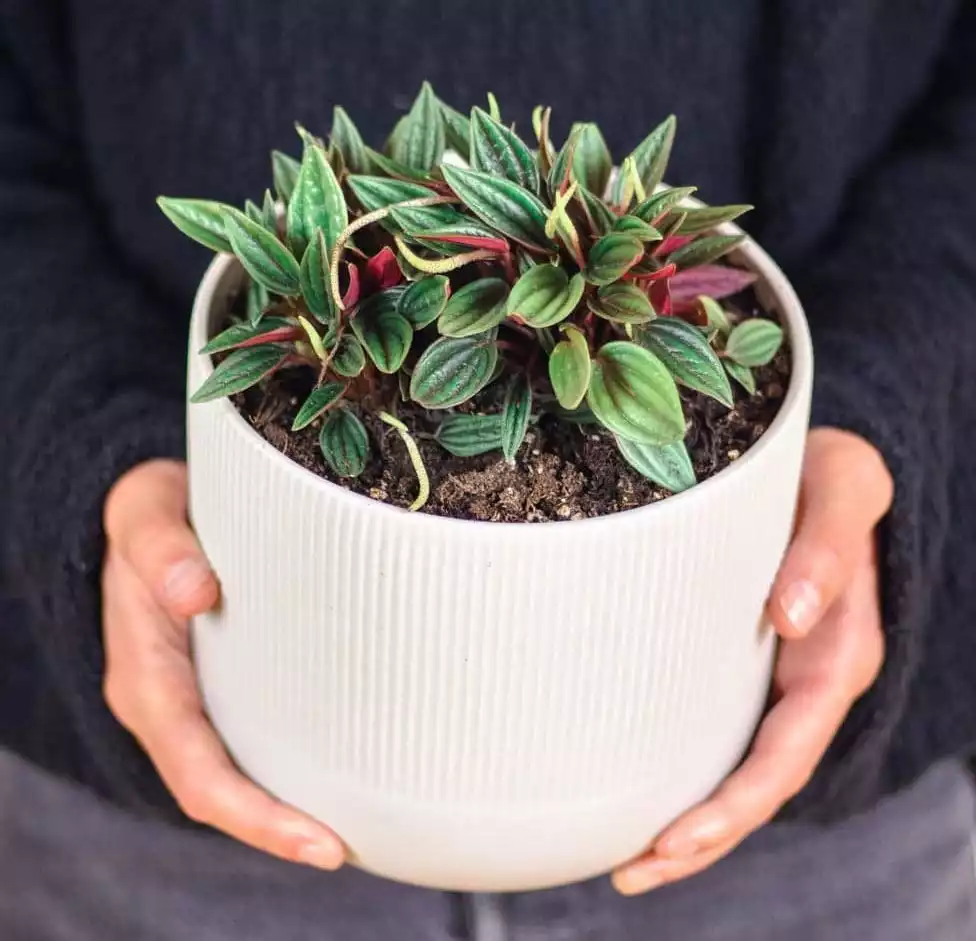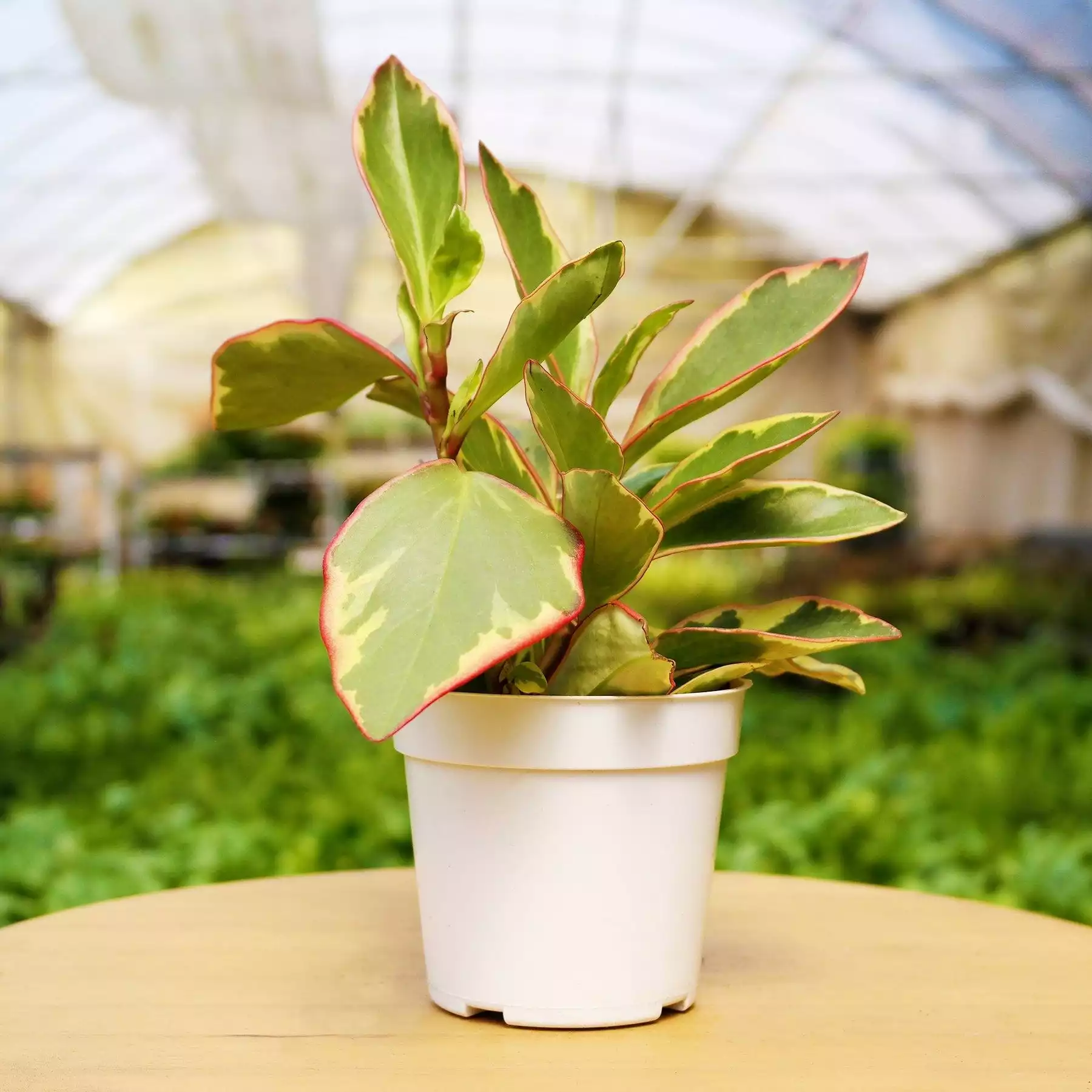You can find peperomia in all types of colors, including green, brown, red, yellow, pink, and purple. They are often known as “Radiator Plants” and can be grown either in the house or in an outdoor garden.
There are a ton of peperomia varieties to choose from, so I made this list to help you determine which will make a great addition to your home or office.
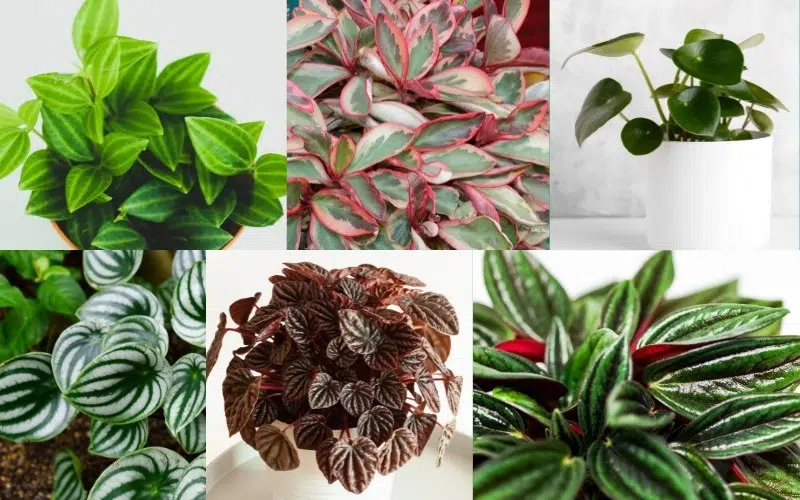
The best part is that the full range of peperomia plants are considered non-toxic for dogs and cats per the ASPCA.
Peperomia is a type of houseplant that is considered low-maintenance, but that doesn’t mean it’s an easy one to care for. Just like succulents, you can easily overwater peperomia.
Most peperomia do not need much direct sunlight to thrive but require indirect sunlight during the hottest part of the day.
The Best Peperomia Varieties
There are types of Peperomia that are trailing varieties for hanging baskets or containers, and some with colorful foliage like the Peperomia obtusifolia, and many more.
Baby Rubber Plant (Peperomia obtusifolia)
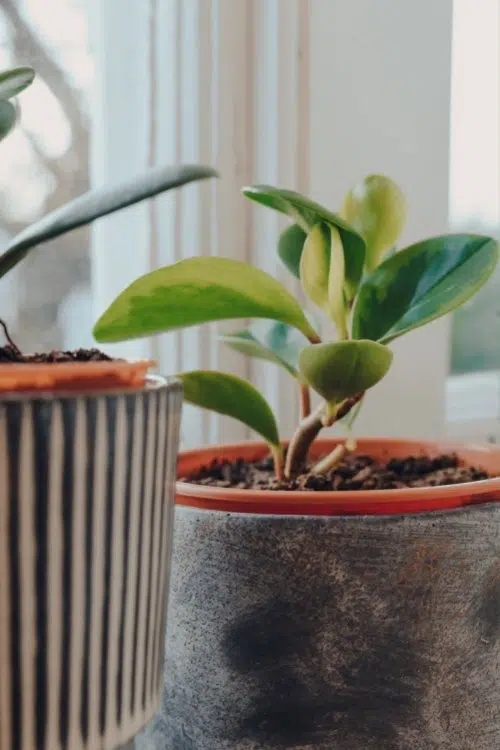
- Light Requirements: Indirect, low light
- Watering Schedule: Every 1-2 weeks
- Difficulty: Easy
- Height: 10 inches
- Repotting: Once every two years or as needed
Peperomia Baby Rubber Plant (Peperomia obtusifolia) is an interesting and colorful variety that can be grown both inside or outside.
Baby rubber plants should be sprayed with water two to three times a week when it’s housed outdoors, and only needs watering once every couple of weeks when kept indoors.
Sometimes called “Benny” or “Baby Rubber Plant”, it’s a good choice to grow in an office or other indoor workspace because its leaves aren’t messy like some of the larger peperomia houseplants.
The Peperomia Obtusifolia Variegata is a similar variety, but has variegated (split color) leaves.
Watermelon peperomia (Peperomia argyreia)
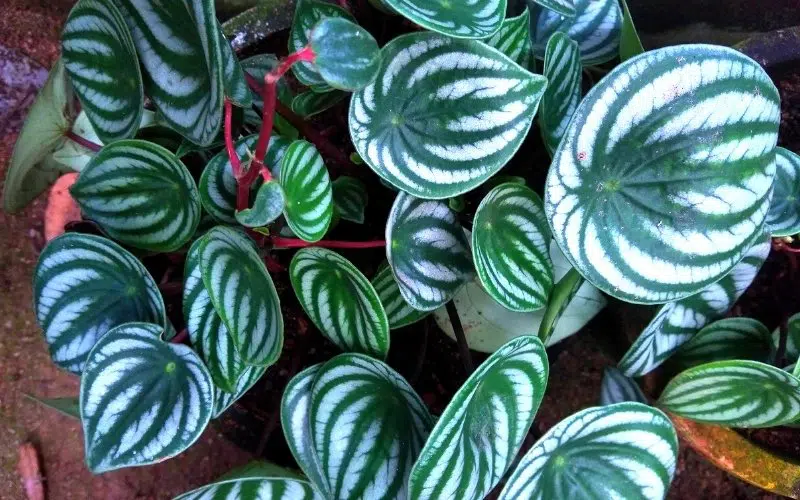
- Light Requirements: Indirect, bright light
- Watering Schedule: Water when 1-2 inches of top soil is dry; Every1-2 weeks in the summer and 3-4 weeks in the winter
- Difficulty: Easy
- Height: 12 inches
- Repotting: In the spring, once every 2-3 years
Watermelon peperomia is one of my favorites and is quickly becoming a star of the houseplant community.
The leaves of this plant are dark green with stripes of white and pink, giving it a watermelon effect. Its small size makes it perfect for desktops and your empty windowsill.
The Peperomia Watermelon is considered a relatively rare plant, but Cellar Door Plants offer these beauties for a great price.
Peperomia Hope (Peperomia tetraphylla)
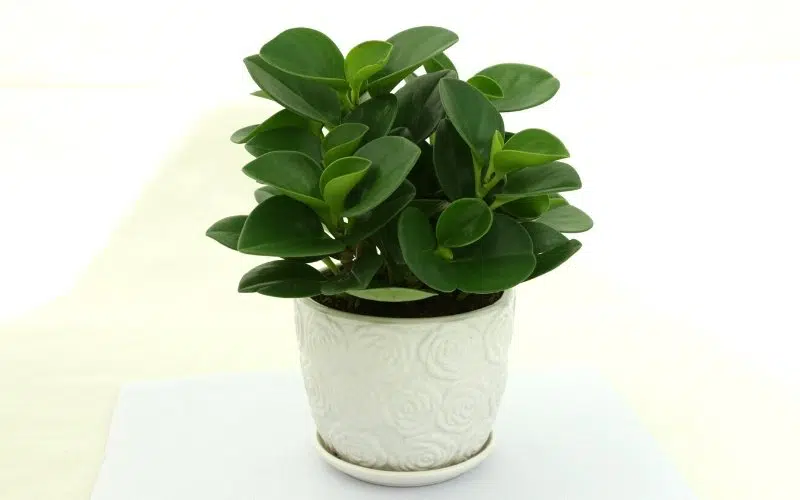
- Light Requirements: Partial sunlight
- Watering Schedule: Every 2 weeks
- Difficulty: Easy
- Height: 12+ inches (trailing plant)
- Repotting: In the spring, once every 2-3 years
Can be planted in a hanging basket indoors or outdoors.
Peperomia Hope has dark green leaves with red and white edges. Like other peperomia, it can be propagated by taking cuttings or new stem tips from the plant, but it’s not as easy to propagate as some of the other peperomia varieties.
Peperomia Hope is a newer variety that is becoming more popular because of its unique shape.
String of Turtles Peperomia Plant (Peperomia prostrate)
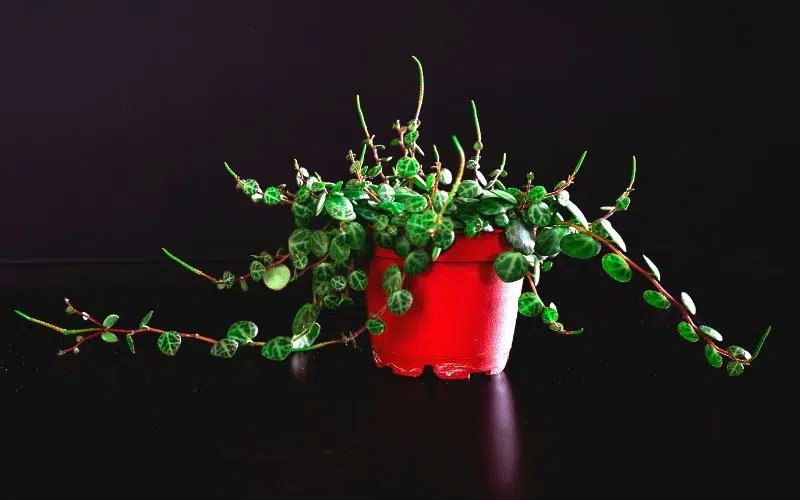
- Light Requirements: Indoors, this peperomia likes bright but indirect sunlight. Outdoors the String of Turtles plant does well in part sun and can be used as a hanging plant outside during the warmer summer months.
- Watering Schedule: Every 2-3 weeks, only when soil is dry
- Difficulty: Easy
- Height: 12 inches indoors; 24 inches outdoors (trailing plant)
- Repotting: In spring, every 2-3 years
String of Turtles is one that likes to be left alone for a long time. Over time, they form clusters of tiny new plants that grow around the main plant.
String of Turtles likes to be outside during the warm summer months but can be kept indoors in a bright spot during winter.
It will grow well with just indirect sunlight year-round; however, more sun will make its leaves bigger and healthier. When grown outdoors it should be watered regularly as it will dry out faster. But you’ll want to let it dry for 4-5 weeks in the winter.
Red Ripple Peperomia (Peperomia caperata)
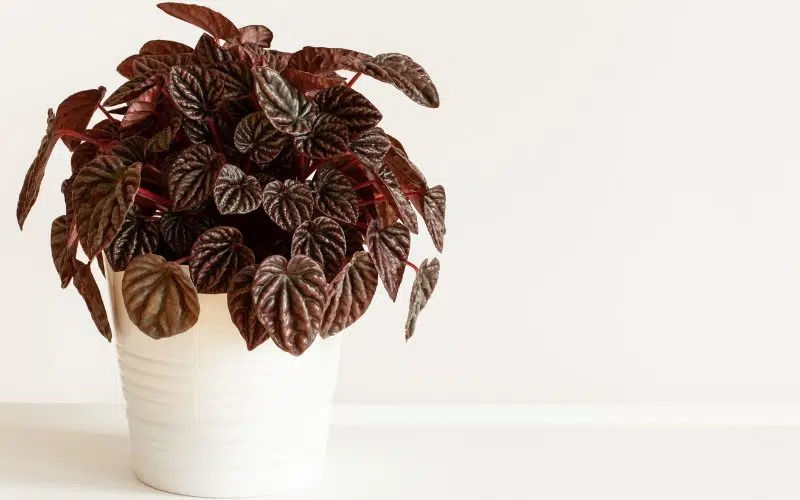
- Light Requirements: Indoors this peperomia likes bright but indirect sunlight. Outdoors the Red Ripple plant does well in part sun and can be used as a hanging plant outside during the warmer summer months.
- Watering Schedule: Once a week in spring; once every 2-3 weeks in winter
- Difficulty: Easy
- Height: 12+ inches (trailing plant)
The leaves of the Red Ripple peperomia houseplant are shaped like a heart and grow in clusters.
Peperomia caperata is easy to care for, but it does need to be watered regularly during the warm summer months. During winters outdoors you should not water these peperomia houseplants until new growth begins in spring. You can place them inside during cold winter months as they won’t survive outside in the cold weather, like most other peperomias.
Emerald Ripple Peperomia (Peperomia caperata)
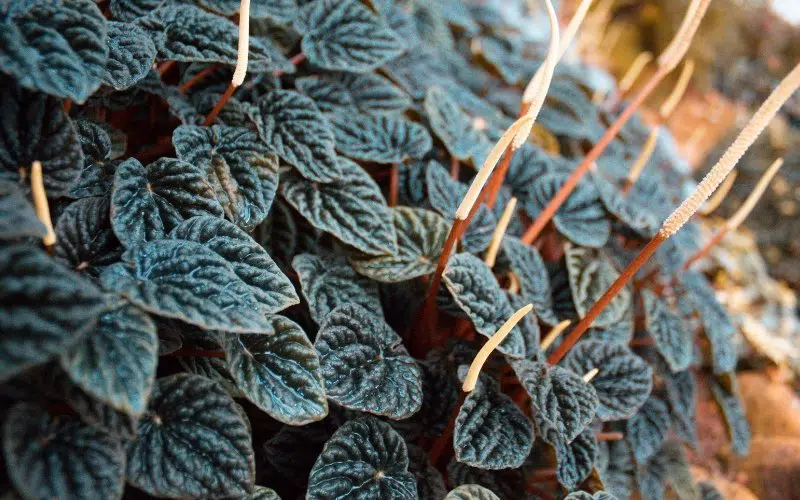
- Light Requirements: Indoors this peperomia likes bright but indirect sunlight. Outdoors the Emerald Ripple plant does great in part sun.
- Watering Schedule: Once a week in spring; once every 2-3 weeks in winter
- Difficulty: Easy
- Height: 8 inches
The Emerald Ripple Peperomia is a small houseplant from Brazil, that has glossy, green leaves that can turn reddish-purple during the cold months. Much like other Peperomia plants, the Emerald Ripple Peperomia produces small white flowers off of stems that come up between the leaves.
Peperomia Caperata “Variegata”
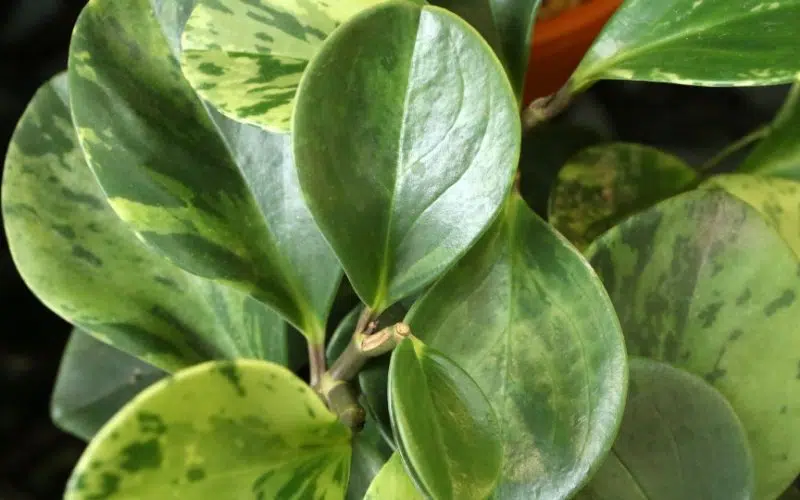
- Difficulty: Easy
- Watering Schedule: Once a week in spring; once every 2-3 weeks in winter
Another popular peperomia plant for decoration is the Peperomia caperata “Variegata.” With similar characteristics to the “Tricolor,” it has attractive green and white variegated leaves. They grow in heart-shaped clusters that can be removed from the mother plant and propagated on their own.
Peperomia Caperata “Tricolor”
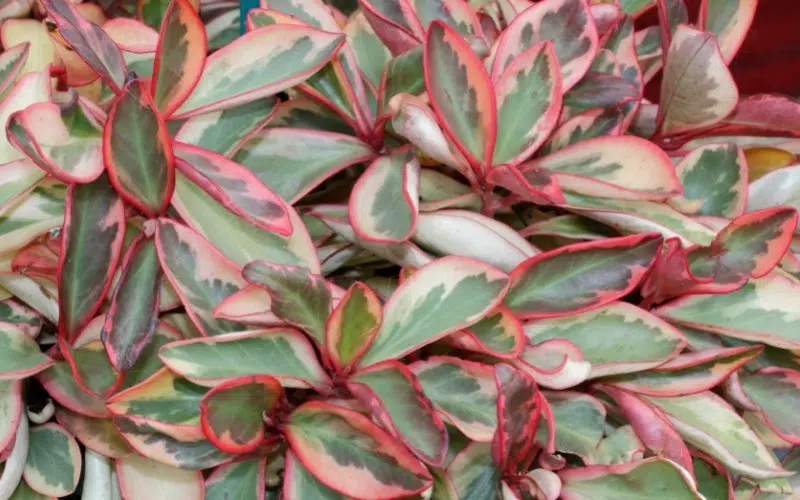
- Difficulty: Easy
- Height: 12 inches indoors; 24+ inches outdoors (trailing plant)
- Light Requirements: Indoors this peperomia likes bright but indirect sunlight. Outdoors the Emerald Ripple plant does great in part sun.
- Watering Schedule: Once a week in spring; once every 2-
The Peperomia caperata “Tricolor” is one of my favorites. It has colorful variegated leaves that are light green, white and red.
Tricolor plants can be kept indoors but needs bright indirect light to stay healthy.
Silver Frost Peperomia (Peperomia Frost)
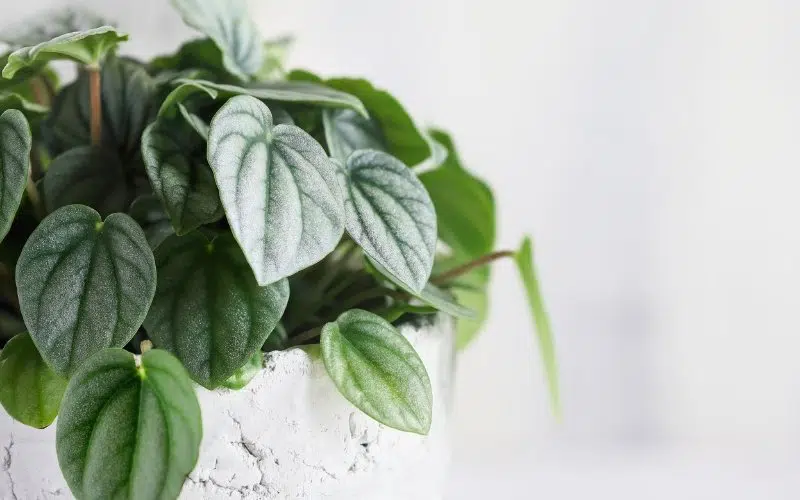
- Light Requirements: Bright indirect sunlight
- Watering Schedule: Once every 2-3 weeks in winter; once a week during spring and summer months.
- Difficulty: Easy
- Height: 6-12 inches
The leaves of the Silver Frost Peperomia houseplant are thick and soft, and have a silvery-white color that really stands out, thus the silver frost name.
Although it prefers bright light, you can place it near a window that gets partial sun for most of the day. The Silver Frost Peperomia is relatively short, reaching only 6 inches.
The Silver Frost Peperomia is resistant to insects and disease; its thick stems make it durable enough to handle the outdoor elements year-round.
Metallic peperomia (Peperomia rosso)
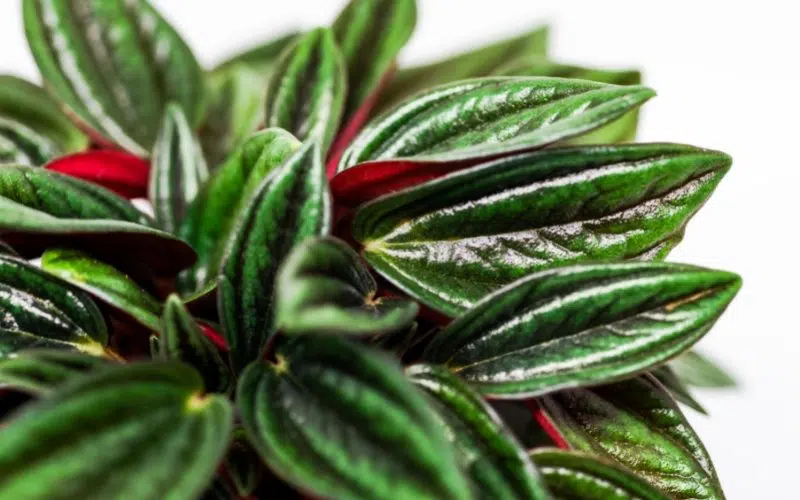
- Light Requirements: Bright indirect sunlight
- Watering Schedule: Once a week in spring; once every 2-3 weeks in winter.
- Height: 6 inches indoors; up to 36 inches outdoors (trailing plant)
- Difficulty: Easy
The Metallic peperomia is another easy houseplant for beginners.
It has really cool looking dark red and grey-green leaves.
Light Requirements: Bright indirect sunlight
Watering Schedule: Once a week in spring; once every 2-3 weeks in winter.
Height: 6 inches indoors; up to 36 inches outdoors (trailing plant)
Difficulty: Easy
The leaves of the Rosso get thicker as they mature, adding to the plant’s durability outdoors.
The Metallic Peperomia is an easy-to-grow indoor houseplant and will do best in a planter with good drainage. The peperomia houseplant prefers bright indirect sunlight but can handle lower light conditions for a period of time.
Ruby Glow (peperomia graveolens)
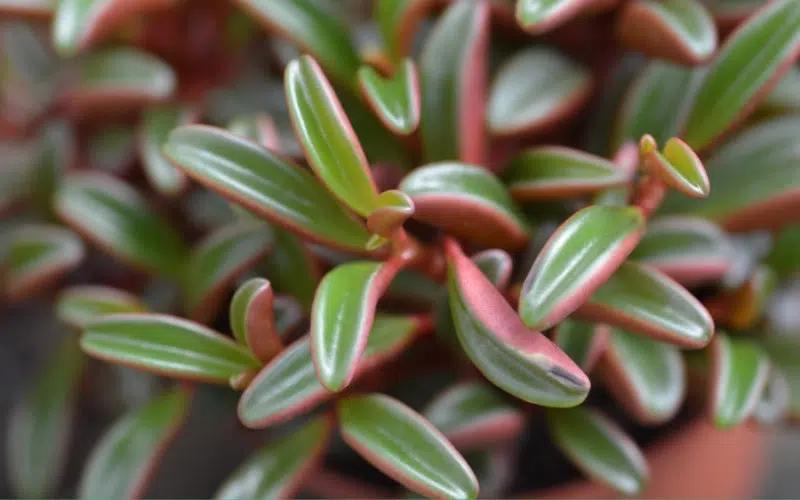
- Difficulty: Easy
- Height: 8 to 10 inches indoors; up to 12 feet outdoors (trailing plant)
- Light Requirements: Indoors, bright indirect sunlight; outdoors it will do well in partial shade. Outdoors, the peperomia houseplant prefers morning sun and afternoon shade.
- Watering Schedule: Once a week in spring; once every 2 weeks in summer.
This peperomia has large, thick leaves that vary from a light green to a dark purple depending on the amount of sunlight it gets.
It prefers bright indirect sunlight but can manage low light conditions for a few hours per day.
You’ll get the best colors out of this plant if its watered properly. If you are growing it outside, water it once the top inch of soil feels dry to the touch. This peperomia houseplant prefers warm temperatures and the soil should be kept slightly moist.
Ginny Peperomia (Peperomia clusiifolia)
- Difficulty: Easy
- Height: 1-2 feet
- Light Requirements: Low light
- Watering Schedule: Once every 2 weeks, when the top several inches of soil get dry
- Repotting: Every 1-2 years
The peperomia ginny is one of my favorites and is pretty popular. It has tricolored leaves that are almost like variegated leaves with a red border around them.
- Difficulty: Easy
- Height: 1-2 feet
- Light Requirements: Low light
- Watering Schedule: Once every 2 weeks, when the top several inches of soil get dry
- Repotting: Every 1-2 years
It’s also one of the most forgiving plants you can grow, which is great for those of your with supposed black thumbs. It will do well if you forget to water it for a while, just don’t leave it dry for more than two weeks at a time.
It’s also tolerant of low light, so it should be able to stay indoors if that is your preference.
The peperomia ginny prefers temperatures between 60 and 70 degrees F and will do great under fluorescent lighting or in a south-facing window.
Jayde Peperomia (Peperomia polybotrya)
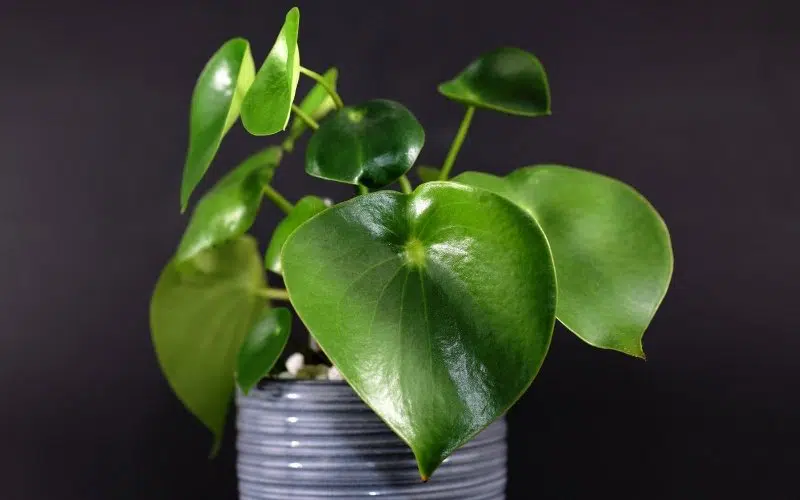
- Difficulty: Easy
- Height: 1 to 2 feet indoors; up to 6 feet outdoors (trailing plant)
- Light Requirements: Indoors, bright indirect sunlight. Outdoors, the peperomia houseplant prefers morning sun and afternoon shade.
- Watering Schedule: Once a week in spring; once every 2-3 weeks in summer.
Just look at that beauty!
The Jayde peperomia, also called the Polybotrya peperomia or Green-margined Peperomia, has dark green leaves with a lighter outline of them. The leaves get wider instead of longer as the plant grows.
Peperomia Ruby Cascade
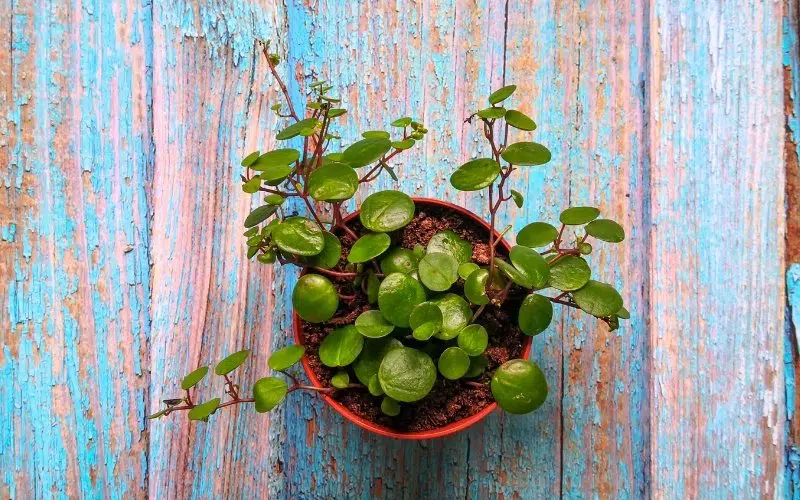
- Difficulty: Moderate
- Height: Up to 2 feet indoors; up to 10 feet outdoors, depending on the conditions of the soil.
- Light Requirements: High light, such as southern exposure with 3-4 hours of sunlight a day.
- Watering Schedule: Once every week or so when the top few inches of soil feel dry.
The ruby cascade can grow up to 10 feet long, but usually stays shorter than that indoors. This peperomia houseplant is not quite as forgiving of being neglected like some of the others on this list.
The Peperomia Ruby Cascade prefers drier soil and its ideal conditions are about 50-70 degrees F during the day with high humidity.
Peperomia Nivalis
- Height: 4-6 inches
- Light Requirements: Bright light, no direct sunlight
- Watering Schedule: Keep soil moist, but not “Wet”
- Difficulty: Moderate, needs high light and humid conditions.
Peperomia nivalis is an ideal low-light houseplant that does great with just a few hours of sunlight each day.
This peperomia houseplant prefers rich, moist soil with plenty of peat moss for added drainage.
It’s a great choice for an office or cubicle as indirect light is perfect for this variety.
Happy Bean Plant (Peperomia Ferreyrae)
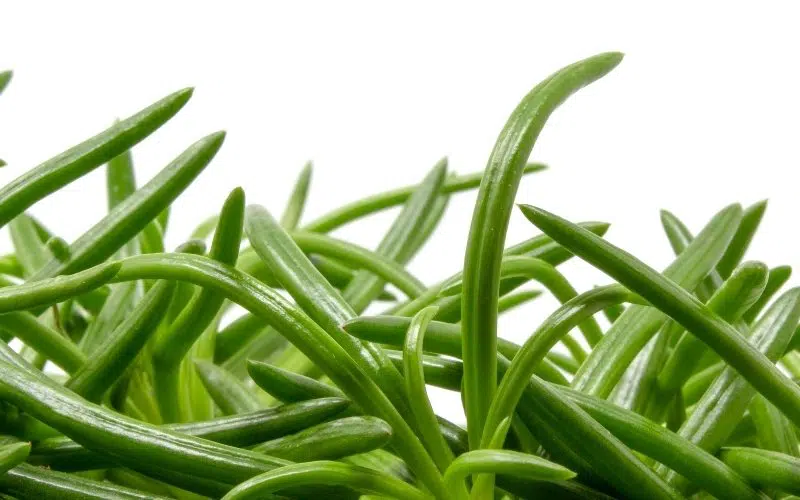
- Difficulty: Moderately easy if planted in the ground. Difficult indoors.
- Height: 12-18 inches
- Light Requirements: Bright, indirect light
- Watering Schedule: Once a week when the soil feels dry
This actually just looks like a bunch of happy beans. So cool.
The peperomia ferreyrae does require lots of light and good air circulation. While it needs a lot of light, it need to be indirect light. Also making it a good option for a desk plant, but it might make you hungry throughout the day if you like green beans. Ha.
Teardrop Peperomia (peperomia pixie)
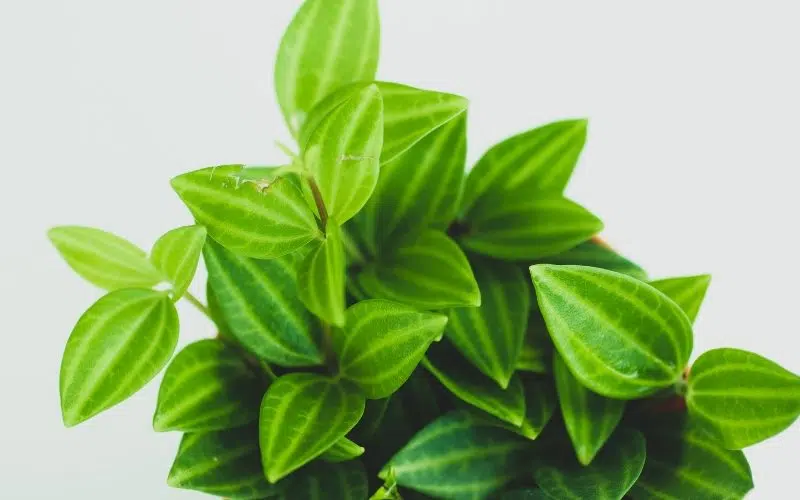
- Difficulty: Moderately easy
- Height: 3-4 inches
- Light Requirements: Bright indirect light; 3-4 hours of strong southern light a day
- Watering Schedule: Once a week when the soil feels dry
Pepperomia Pixie is one that looks like it just belongs on your desk. It’s an upright variety vs trailing ones, that has scalloped leaves and flat, fuzzy stems.
This one is easy to grow as it only needs low or medium indirect light. The Pixie doesn’t like to have very dry soil, so make sure to check it regularly.
Vining Peperomia (peperomia serpens)
- Difficulty: Easy
- Height: 3-4 feet
- Light Requirements: Partial shade; dappled or direct sunlight for only 2-4 hours a day
- Watering Schedule: Once a week when the top 1-2 inches of soil feels dry
- Repotting: Rarely, but give it fresh soil every year
The Vining Peperomia is a trailing peperomia that has green, heart-shaped leaves. IT originated in South American jungles so they are native to a tropical climate and like humidity.
Trailing Jade (Peperomia rotundifolia)
- Difficulty: Easy
- Height: 12-18 inches, spreading
- Light Requirements: Bright indirect light; dappled or strong southern light for at least 4 hours a day.
- Watering Schedule: Once a week when the soil feels dry
The Peperomia rotundifolia is one of my favorite houseplants because it’s so hard to kill. Woohoo!
It originated from the rain forests of South America, and it tends to prefer a humid environment when grown indoors. It was discovered in crevices, old fallen trees, and crawling across the ground.
Give it bright indirect light, dappled, or strong southern light for at least 4 hours a day. Water when the top soil feels dry, but cut back on watering during winter months as it will use less.
Cupid Peperomia (Peperomia Scandens ‘Variegata’)
- Difficulty: Low maintenance
- Height: 4-6 inches
- Light Requirements: Indirect or dappled, bright light
- Watering Schedule: Once every 1-2 weeks; when top 2 inches is dry
These make great hanging plants as their vines with beautifully dangle from the pot. But it is easy to overwater them, so make sure to check soil before watering.
Peperomia Puteolata
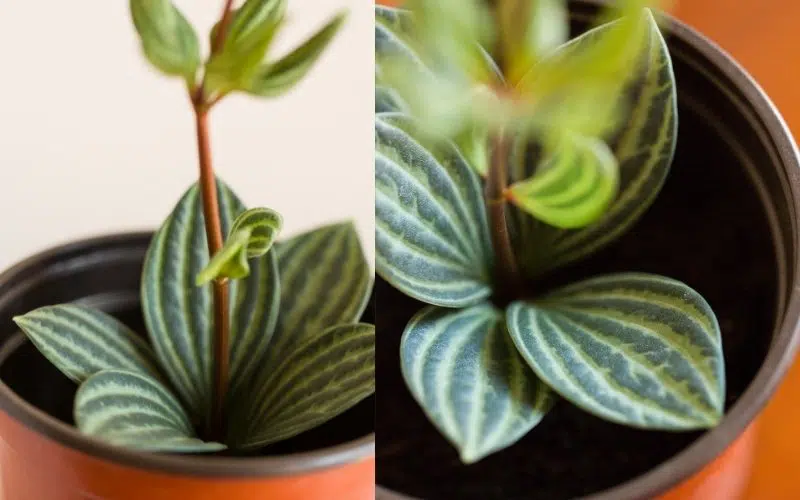
- Difficulty: Easy
- Height: 18 inches
- Light Requirements: Bright, indirect light
- Watering Schedule: Only water when top few inches of soil dries out
Peperomia puteolata, more commonly known as the parallel peperomia, is a small to medium-sized peperomia with green or grey-green leaves. Fun fact, these leaves actually turn different shades of red in direct sunlight.
Peperomia puteolata needs to be placed in a shaded area, as the bright sunlight causes leaf burn.
Pink Lady Peperomia (Peperomia obtusifolia)
- Difficulty: Easy
- Height: 6-10 inches
- Light Requirements: Partial shade to indirect light
- Watering Schedule: Every 1-2 weeks
Pink lady peperomias has round leaves, and flattened stems and grow well in any soil as long as it is kept moist.
The plant’s flowers grow on spikes in summer. To keep the plants in flower, cut off some of the spikes before they set seed and mature (aka deadheading the plant).
Roundleaf Peperomia (peperomia orba)
Peperomia orba is a creeping perennial woody vine that has really dark green, variegated leaves and white flowers.


